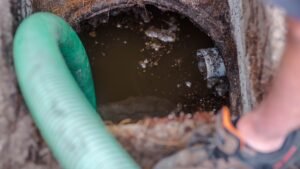Your septic tank works quietly behind the scenes until it doesn’t. Homeowners and property managers need to catch the warning signs before a full septic tank becomes a messy, expensive problem that disrupts daily life. How do you know when your septic tank is full ? Learn the common signs, warning symptoms, and when to schedule pumping to avoid costly damage.
Knowing how to tell if your septic tank is full can save you thousands in emergency repairs and protect your family’s health. A full septic tank doesn’t just stop working – it can cause sewage backups, foul odors, and environmental contamination around your property.
We’ll walk you through the key warning signs that show your septic system needs attention, from slow drains and gurgling sounds to wet spots in your yard. You’ll also learn simple inspection methods you can do yourself and discover when it’s time to call in the pros for pumping or repairs.
Recognize the Warning Signs Your Septic Tank is Full
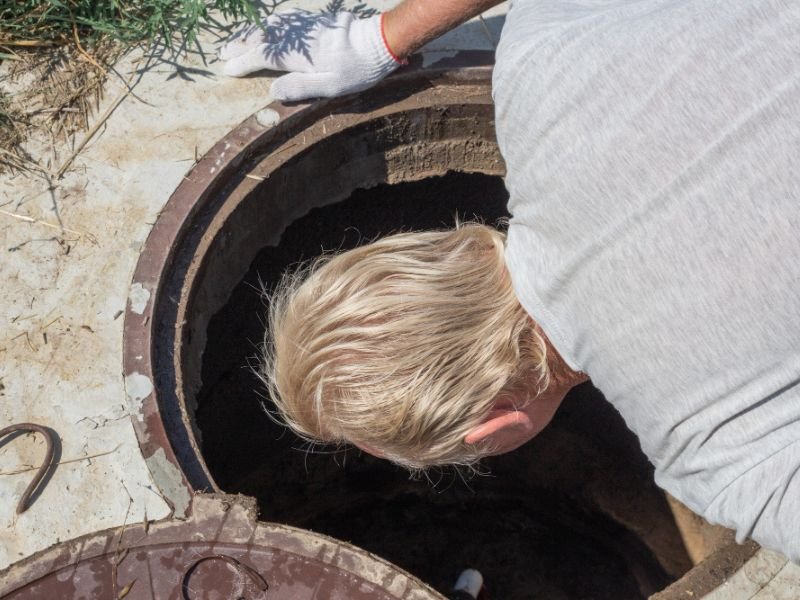
Slow Draining Fixtures Throughout Your Home
When your septic tank reaches capacity, one of the first things you’ll notice is water moving sluggishly through your plumbing system. Your bathroom sink might take forever to empty after brushing your teeth, or the shower water pools around your ankles longer than usual. This slowdown happens because wastewater has nowhere to go when the tank can’t accept any more liquid.
Kitchen sinks often show these symptoms first since they handle the most wastewater throughout the day. You might find yourself waiting several minutes for dishwater to drain completely. Laundry sinks and utility room drains also become noticeably slower, creating inconvenience during routine household tasks.
Multiple fixtures draining slowly at the same time is a telltale sign your septic system needs attention. A single slow drain usually points to a localized clog, but when every drain in your house struggles, the problem lies deeper in your septic system.
Sewage Backup in Toilets and Drains
Nobody wants to deal with sewage backup, but recognizing this warning sign early can save you from a major disaster. When your septic tank fills beyond capacity, wastewater has to go somewhere – and unfortunately, that somewhere is often back up through your lowest drains.
Toilets typically show the first signs of backup because they sit at the lowest point in most plumbing systems. You might notice water levels rising higher than normal after flushing, or worse, sewage bubbling up from the toilet bowl. Floor drains in basements, utility rooms, or garages are also common backup points.
Shower and bathtub drains can also experience backup when septic tanks reach their limit. Standing water mixed with unpleasant debris becomes a clear signal that your system can’t handle incoming wastewater. This backup creates unsanitary conditions and requires immediate attention to prevent health hazards and property damage.
Foul Odors Around Your Property
Your nose often provides the first warning that something’s wrong with your septic system. A full septic tank creates distinct smells that drift across your property, especially during warm weather or humid conditions.
Near your septic tank location, you might detect strong sewage odors that weren’t there before. These smells become more pronounced around the drain field area where treated wastewater normally filters into the soil. When the tank overflows, untreated waste creates particularly offensive odors that neighbors might even notice.
Inside your home, drain odors become more frequent and intense. Bathroom and kitchen drains might emit sewer gases that make spending time in these rooms unpleasant. These indoor smells often worsen after heavy water usage like running multiple loads of laundry or taking long showers.
The septic vent pipe on your roof might also release stronger odors than usual. While some smell is normal from this vent, intensified odors signal that your system is working overtime to process more waste than it can handle.
Gurgling Sounds from Plumbing Fixtures
Strange sounds coming from your plumbing can indicate serious septic problems brewing beneath the surface. When your septic tank fills up, air gets trapped in the system and creates distinctive gurgling noises as water tries to move through blocked passages.
Toilets often produce the most noticeable gurgling sounds. You might hear these noises when flushing or even when other fixtures drain elsewhere in the house. The sound resembles air bubbles forcing their way through liquid, which is exactly what happens when your septic system backs up.
Sink drains also make unusual gurgling sounds when septic tanks reach capacity. These sounds occur most frequently when you’re draining large amounts of water, like emptying a full kitchen sink or finishing a long shower. The gurgling indicates that air is displacing water that should be flowing freely through your septic system.
Listen carefully to your plumbing during quiet moments of the day. New or intensified gurgling sounds that coincide with other warning signs strongly suggest your septic tank needs pumping or professional attention.
Identify Physical Evidence Around Your Septic System
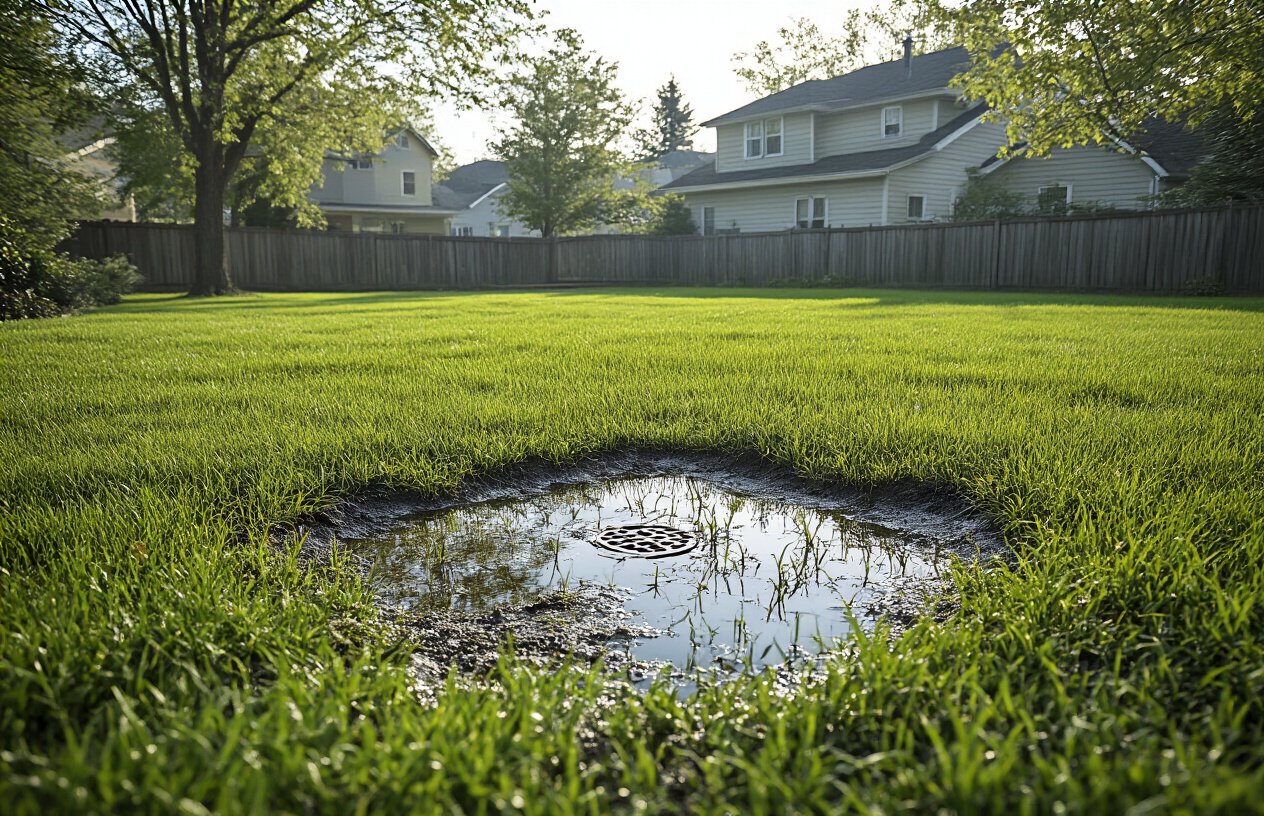
Standing Water or Wet Spots in the Drain Field
Water pooling around your septic system tells a clear story – your tank has reached capacity and wastewater can’t properly drain through the soil. When you spot standing water or soggy patches in your drain field area, especially during dry weather, your septic tank is likely full and struggling to process waste efficiently.
These wet spots typically appear as dark, muddy patches that remain damp even days after rain. The water may have a foul odor and appear darker than regular rainwater. Pay special attention to areas directly above your septic tank and drain field lines, as these locations show the first signs of backup.
Check these areas regularly by walking around your septic system after dry spells. If you notice persistent moisture or small puddles forming without recent precipitation, your system is probably overwhelmed. The saturated soil can’t absorb additional liquid waste, causing it to surface instead of filtering properly underground.
Lush Green Grass Growth Over the Septic Area
Grass growing exceptionally well over your septic tank and drain field can signal that your septic tank is full of water and nutrients are leaching into the surrounding soil. While this might seem like a positive sign, it actually indicates your system isn’t containing waste properly.
The rich nitrogen content in septic waste acts like fertilizer, creating noticeably greener, thicker grass compared to other areas of your lawn. This lush growth appears most prominently during growing seasons and creates distinct patterns that outline your septic system components.
Look for grass that grows faster, appears darker green, or stays green longer than surrounding areas. These “hot spots” of vegetation growth directly correspond to where excess nutrients from your full septic tank are reaching the surface soil. During winter months, you might notice these areas stay unfrozen or snow melts faster over your septic system.
Visible Sewage on Ground Surface
The most alarming physical evidence appears when raw sewage becomes visible on your property’s surface. This happens when your septic tank is full and can no longer contain waste, forcing sewage to back up through the system and emerge above ground.
Sewage surfacing creates dark, wet patches with unmistakable foul odors around your septic tank, distribution box, or drain field. You might see toilet paper, solid waste, or greyish-black liquid pooling in low-lying areas near your septic components. This sewage often attracts flies and creates health hazards for your family and pets.
Don’t ignore even small amounts of surface sewage, as this indicates your septic system has completely failed to process waste properly. The situation will worsen quickly without immediate professional intervention. Take photos of affected areas and avoid direct contact with contaminated soil or water while documenting the problem for septic service professionals.
Monitor Your Household’s Water Usage Patterns
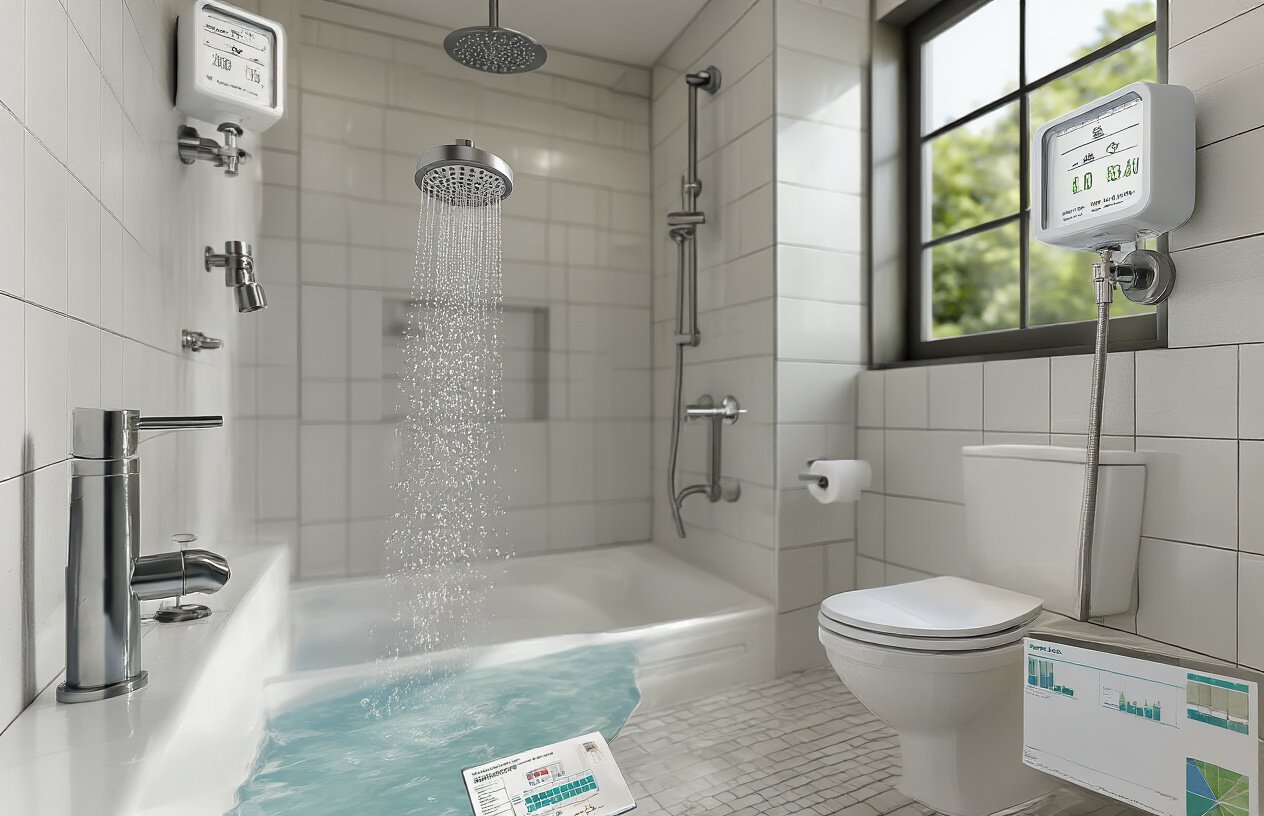
Calculate Your Family’s Daily Water Consumption
Understanding your household’s water usage helps predict when your septic tank might reach capacity. The average person uses 70-100 gallons of water daily, but this varies based on family size, habits, and appliances.
Start by counting how many people live in your home full-time. Multiply this number by 80 gallons to get a baseline estimate. A family of four typically uses around 320 gallons per day. However, modern high-efficiency appliances can reduce this number, while older fixtures may increase it.
Pay attention to water-heavy activities that affect your septic system. Long showers, frequent laundry loads, and running dishwashers multiple times daily all contribute to your tank filling faster. If you notice your family’s water habits have changed recently, your septic tank timeline changes too.
Consider seasonal variations in usage. Summer months often see increased water consumption from lawn irrigation, pool filling, or extended family visits. Winter holidays with house guests can also spike your daily water output significantly.
Track Time Since Last Septic Pumping Service
Most septic tanks need pumping every 3-5 years, but this timeline depends heavily on tank size and household usage. Smaller tanks (under 1,000 gallons) serving large families may need attention every 1-2 years, while larger systems might go 5-7 years between services.
Keep detailed records of your last pumping service, including the date, company used, and any notes about tank condition. Many homeowners forget these crucial details, making it harder to predict when the next service is due.
Create a simple tracking system using your phone’s calendar or a notebook. Mark the pumping date and set reminders for future inspections. Professional septic companies often provide stickers with service dates that you can place inside your electrical panel or another memorable location.
If you’re unsure about your tank’s pumping history, contact previous homeowners or check local health department records. Many municipalities require permits for septic services, creating a paper trail you can access.
Account for Recent High-Usage Events
Special circumstances can dramatically accelerate how quickly your septic tank fills. House guests staying for extended periods, holiday gatherings, or temporary lifestyle changes all impact your system’s capacity.
Recent parties, family reunions, or overnight visitors mean your septic tank is processing much more waste than usual. A weekend with six extra people can add 400-500 gallons of wastewater to your system – equivalent to nearly two days of normal family usage compressed into 48 hours.
Construction projects, home renovations, or increased work-from-home schedules also affect septic tank filling rates. More people home during the day means more bathroom usage, additional loads of laundry from dusty work clothes, and increased overall water consumption.
Weather events can impact your septic system too. Extended periods of rain may saturate your drain field, preventing proper wastewater absorption and causing your tank to retain more liquid than normal. This situation mimics a full tank even when solid waste levels are manageable.
Document these high-usage periods in your septic maintenance log. Understanding these patterns helps you recognize when your septic tank is full and prevents unexpected backups or overflows.
Perform Simple DIY Inspection Techniques

Check Septic Tank Lid Access Points
Before you can inspect your septic tank properly, you need to locate and access the inspection ports. Most septic tanks have two access points: one over the inlet baffle and another over the outlet baffle. These lids are typically circular concrete or plastic covers that sit flush with the ground or slightly below surface level.
Start by locating your septic system diagram or permit records, which should indicate the approximate position of your tank. If you don’t have these documents, look for areas in your yard where the grass grows differently or appears greener than surrounding areas. Use a metal probe or long screwdriver to gently probe the ground in a grid pattern until you feel the solid tank lid beneath.
Once you find the lids, carefully remove them using a pry bar or specialized septic lid lifter. Never enter the tank or put your head directly over the opening – septic tanks contain dangerous gases that can be fatal. Always ensure proper ventilation and never work alone when performing this inspection.
Use a Measuring Stick to Assess Sludge Levels
The measuring stick method is one of the most reliable ways to determine how full your septic tank is. You’ll need a long wooden stick or PVC pipe (at least 8-10 feet long) and a white towel or cloth that you can wrap around the bottom portion.
Lower the stick slowly through the access port until it reaches the bottom of the tank. Leave it in place for about three minutes to allow the different layers to mark the stick. When you pull it out, you’ll see distinct markings that tell the story of what’s happening inside your tank.
The bottom layer of dark, thick material indicates sludge accumulation. The middle section shows relatively clear liquid effluent. At the top, you might notice scum or floating debris. Generally, if the sludge layer is more than one-third of the total tank depth, or if the combined sludge and scum layers exceed half the tank’s capacity, it’s time for pumping.
Observe Liquid Level Through Inspection Ports
The liquid level in your septic tank provides crucial information about system performance. In a properly functioning system, the liquid level should be approximately 8-12 inches below the outlet pipe. If the liquid level is too high, it could indicate a blockage in the drain field or an overfull tank.
Look for the outlet baffle or tee – this is where effluent flows out to your drain field. The liquid should be flowing freely without backing up. If water is pooling near the top of the tank or you can see liquid flowing back toward the inlet side, this suggests your system is struggling to process waste effectively.
Pay attention to the color and consistency of the liquid. Healthy septic tank liquid typically appears dark but relatively clear. If you notice excessive foam, unusual colors, or strong odors beyond the typical septic smell, these could be signs that your tank is overloaded or experiencing other problems.
Document Scum Layer Thickness
The scum layer floats on top of the liquid in your septic tank and consists of oils, grease, and lighter materials. While some scum is normal and expected, excessive buildup can interfere with proper tank function and indicate that pumping is needed.
To measure the scum layer, use a long stick with a flap or paddle attachment that can push through the floating material. Gently push down until you reach the clear liquid below, then measure the thickness. A scum layer exceeding 6 inches typically signals that your tank needs attention.
Document your findings with photos and measurements, including the date of inspection. This creates a valuable record that helps you track changes over time and provides useful information for septic professionals when you need services.
Test Effluent Clarity in Distribution Box
The distribution box is where liquid from your septic tank flows before entering the drain field lines. Checking the clarity of effluent at this point gives you insight into how well your septic tank is processing waste.
Locate your distribution box – it’s usually a smaller concrete or plastic box positioned between your septic tank and drain field. Remove the cover and observe the liquid inside. Clear or slightly cloudy effluent indicates good tank performance, while murky, dark, or foul-smelling liquid suggests problems.
If you notice solid particles or excessive sludge in the distribution box, this means your septic tank is allowing unprocessed waste to pass through. This situation can quickly clog your drain field and requires immediate professional attention. Regular monitoring of effluent clarity helps you catch problems before they become expensive repairs.
Know When to Call Professional Septic Services
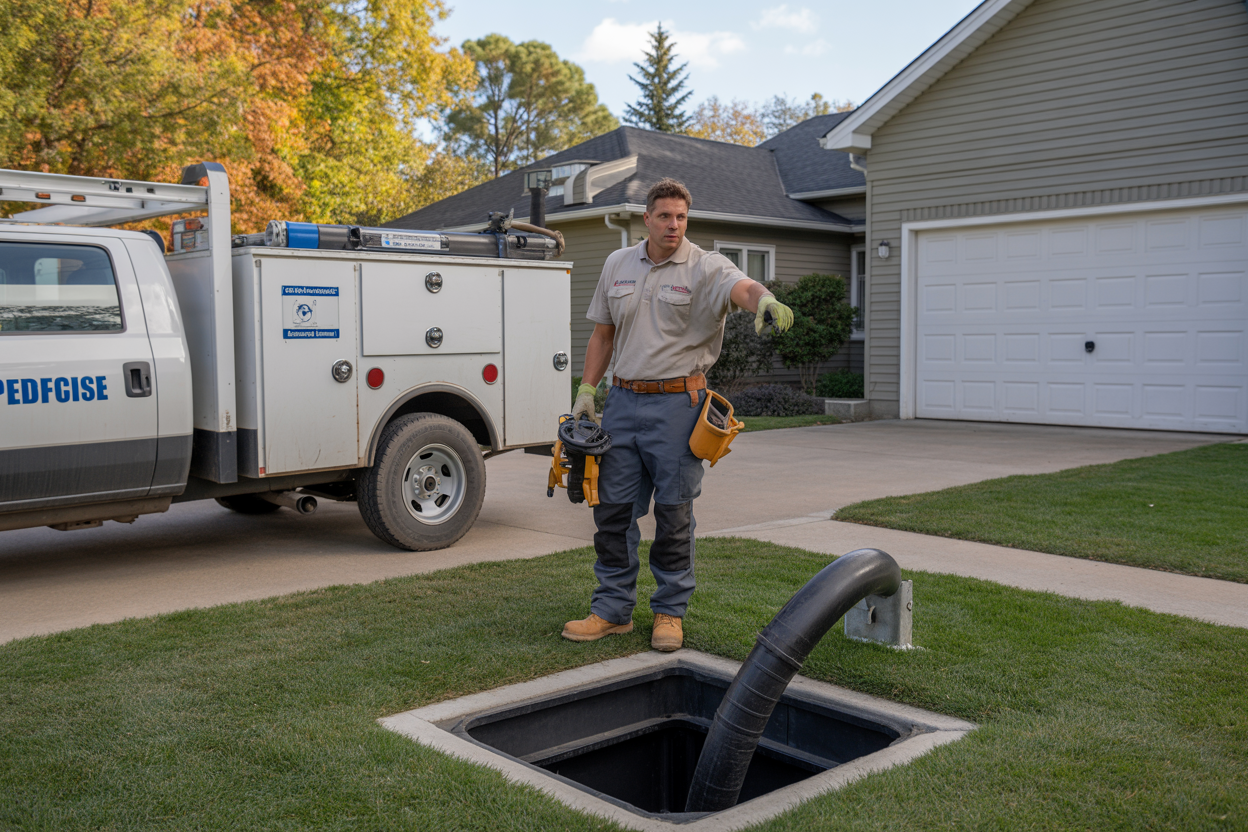
Schedule Regular Pumping Based on Tank Size
Your septic tank needs professional pumping every 3-5 years, but the exact timing depends on several factors. A 1,000-gallon tank serving a family of four typically requires pumping every 3-4 years, while larger tanks can go longer between services. The key is understanding your specific situation rather than guessing.
Professional septic services use specialized equipment to measure sludge levels and determine if your tank is approaching capacity. They can also provide a pumping schedule based on your household size, water usage habits, and tank specifications. This proactive approach prevents the messy and expensive problems that come when you wait until your septic tank is full.
| Household Size | Tank Size | Recommended Pumping Interval |
|---|---|---|
| 1-2 people | 1,000 gallons | 4-5 years |
| 3-4 people | 1,000 gallons | 3-4 years |
| 5-6 people | 1,200 gallons | 2-3 years |
Request Emergency Service for Immediate Issues
Some situations require immediate professional attention, especially when you’re wondering “what happens when septic tank is full” and experiencing severe symptoms. Call emergency septic services if you notice sewage backing up into your home, strong sewage odors throughout your property, or standing water around the drain field.
Don’t wait if multiple drains are backing up simultaneously or if you see actual sewage surfacing in your yard. These signs indicate your septic tank is full of water or waste and poses health risks to your family. Emergency technicians can pump your tank quickly and assess whether additional repairs are needed to prevent future overflows.
Arrange Comprehensive System Inspection
Professional inspections go beyond just checking if your septic tank is full. Certified technicians examine the entire system, including inlet and outlet baffles, distribution boxes, and drain field conditions. They use cameras to inspect pipes and can detect problems before they become expensive repairs.
A comprehensive inspection typically includes:
- Measuring sludge and scum layers
- Testing inlet and outlet flow
- Checking for structural damage
- Evaluating drain field performance
- Identifying potential future issues
Schedule these inspections every 2-3 years or when buying/selling a home. Professional technicians can answer questions like “how long until septic tank is full” based on your current usage patterns and provide maintenance recommendations to extend your system’s lifespan.
Conclusion
When your septic tank reaches capacity, it sends clear signals that shouldn’t be ignored. From slow drains and gurgling toilets to standing water around your drain field, these warning signs protect your home from costly backups and environmental hazards. Pay attention to changes in your water usage patterns too – if things aren’t draining as quickly as usual, your tank might be telling you it needs attention.
Don’t wait until you’re dealing with sewage in your yard or basement. Regular visual checks around your septic system and simple DIY inspections can save you thousands in repairs. While you can handle basic monitoring yourself, calling a professional when warning signs appear is always the smart move. They’ll pump your tank, inspect the system, and help you avoid the mess and expense of a septic emergency.



